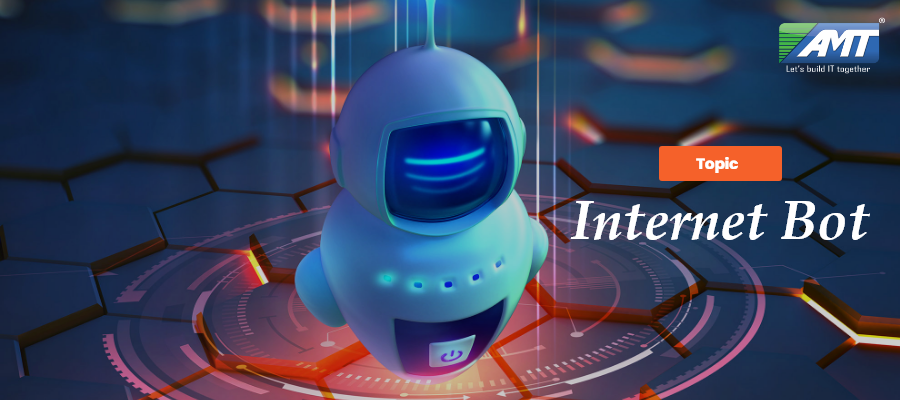An Internet bot, also known as a web robot, robot or simply bot, is a software application that runs automated tasks (scripts) over the Internet. Typically, bots perform tasks that are both simple and structurally repetitive, at a much higher rate than would be possible for a human alone. The largest use of bots is in web spidering (web crawler), in which an automated script fetches, analyzes and files information from web servers at many times the speed of a human. More than half of all web traffic is made up of bots.
Efforts by servers hosting websites to counteract bots vary. Servers may choose to outline rules on the behaviour of internet bots by implementing a robots.txt file: this file is simply text stating the rules governing a bot’s behaviour on that server. Any bot that does not follow these rules when interacting with (or ‘spidering’) any server should, in theory, be denied access to, or removed from, the affected website. If the only rule implementation by a server is a posted text file with no associated program/software/app, then adhering to those rules is entirely voluntary – in reality there is no way to enforce those rules, or even to ensure that a bot’s creator or implementer acknowledges, or even reads, the robots.txt file contents. Some bots are “good” – e.g. search engine spiders – while others can be used to launch malicious and harsh attacks, most notably, in political campaigns.
Some bots communicate with other users of Internet-based services, via instant messaging (IM), Internet Relay Chat (IRC), or another web interface such as Facebook Bots and Twitterbots. These chatterbots may allow people to ask questions in plain English and then formulate a proper response. These bots can often handle many tasks, including reporting weather, zip-code information, sports scores, converting currency or other units, etc. Others are used for entertainment, such as SmarterChild on AOL Instant Messenger and MSN Messenger.
An additional role of IRC bots may be to lurk in the background of a conversation channel, commenting on certain phrases uttered by the participants (based on pattern matching). This is sometimes used as a help service for new users, or for censorship of profanity.
Social networking bots are sets of algorithms that take on the duties of repetitive sets of instructions in order to establish a service or connection among social networking users. Various designs of networking bots vary from chat bots, algorithms designed to converse with a human user, to social bots, algorithms designed to mimic human behaviors to converse with behavioral patterns similar to that of a human user. The history of social botting can be traced back to Alan Turing in the 1950s and his vision of designing sets of instructional code that passes the Turing test. From 1964 to 1966, ELIZA, a natural language processing computer program created by Joseph Weizenbaum, is an early indicator of artificial intelligence algorithms that inspired computer programmers to design tasked programs that can match behavior patterns to their sets of instruction. As a result, natural language processing has become an influencing factor to the development of artificial intelligence and social bots as innovative technological advancements are made alongside the progression of the mass spreading of information and thought on social media websites.
There has been a great deal of controversy about the use of bots in an automated trading function. Auction website eBay has been to court in an attempt to suppress a third-party company from using bots to traverse their site looking for bargains; this approach backfired on eBay and attracted the attention of further bots. The United Kingdom-based bet exchange Betfair saw such a large amount of traffic coming from bots that it launched a WebService API aimed at bot programmers, through which it can actively manage bot interactions.
Bot farms are known to be used in online app stores, like the Apple App Store and Google Play, to manipulate positions or to increase positive ratings/reviews.
A rapidly growing, benign, form of internet bot is the chatbot. From 2016, when Facebook Messenger allowed developers to place chatbots on their platform, there has been an exponential growth of their use on that forum alone. 30,000 bots were created for Messenger in the first six months, rising to 100,000 by September 2017. Avi Ben Ezra, CTO of SnatchBot, told Forbes that evidence from the use of their chatbot building platform pointed to a near future saving of millions of hours of human labour as ‘live chat’ on websites was replaced with bots.
Companies and customers can benefit from internet bots. Internet bots are allowing customers to communicate with companies without having to communicate with a person. KLM Royal Dutch Airlines has produced a chatbot that allows customers to receive boarding passes, check in reminders, and other information that is needed for a flight. Companies have made chatbots that can benefit customers. Customer engagement has grown since these chatbots have been developed.
Chat bots are used on a daily basis. Google Assistant and Siri are considered forms of chat bots. Google Assistant and Siri allow people to ask questions and get a response using an AI system. These technological advances are positively benefiting people’s daily lives.
The above is a brief about Internet Bot. Watch this space for more updates on the latest trends in Technology.
